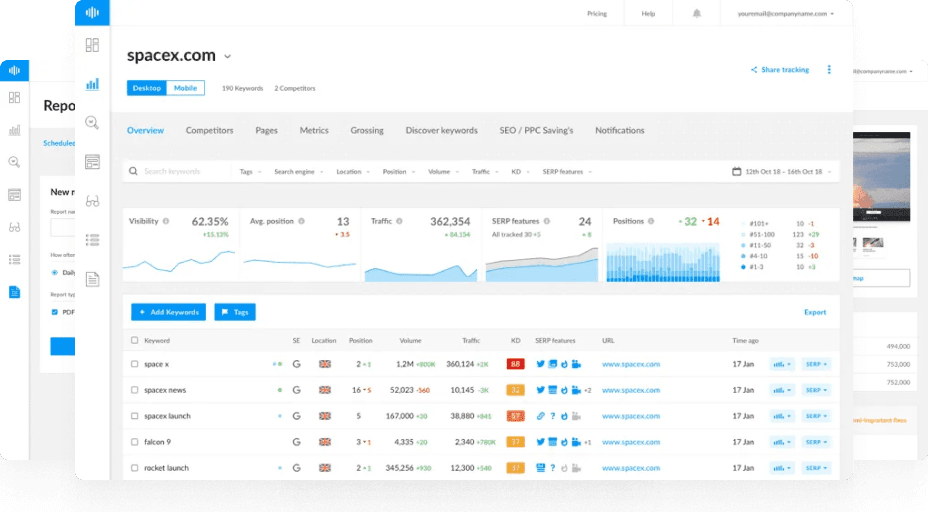What is Entity SEO?
Entity SEO is the practice of optimizing your website’s content, structure, and data around entities — identifiable, real-world objects such as people, organizations, products, events, and concepts — rather than traditional keyword strings.
An entity is something that has a distinct, machine-recognizable identity.
For example:
- “Ranktracker” → organization
- “Google Search” → product
- “E-E-A-T” → concept
- “Felix Rose-Collins” → person
Search engines and AI models like Google Gemini, GPT-4, and Claude 3 rely on entities to understand meaning, relationships, and context — forming the backbone of semantic and generative search.
Entity SEO ensures your content isn’t just readable by humans but understandable by machines, helping search engines and AI systems correctly interpret and associate your brand within their Knowledge Graphs.
Why Are Entities Important in SEO?
Modern search is no longer keyword-based — it’s semantic and contextual. Google’s algorithms like Hummingbird, RankBrain, and BERT shifted toward understanding what users mean, not just what they type.
Entities make this possible by providing structured meaning. When your website clearly defines and links entities, you:
- Strengthen your E-E-A-T signals.
- Improve topical relevance and authority.
- Help LLMs and Knowledge Graphs identify and cite your content.
Example
Instead of optimizing for the keyword “best SEO software,” an entity-based approach defines:
- “Ranktracker” as the software entity.
- “Keyword Finder” as a feature entity.
- “Backlink Checker” as a tool entity.
Then you link these entities together semantically and contextually across your site.
How Entity SEO Works
Entity SEO connects three core layers:
- Identification: Define who or what your content is about (e.g., person, product, company).
- Disambiguation: Clarify which specific entity you mean using structured data and context.
- Connection: Link that entity to related entities within and beyond your site.
Google and AI systems then use these relationships to infer meaning, trust, and relevance.
How to Implement Entity SEO
1. Use Schema Markup Consistently
Add structured data like Organization, Person, Product, Article, and FAQPage to help Google and AI systems understand your entities.
Each schema type defines:
- The entity type
- Attributes (name, URL, description)
- Relationships (sameAs, parent, child, relatedTo)
2. Build a Strong “About” and “Entity Home” Page
Every major entity you own (brand, product, service, person) should have a dedicated, canonical “home” page.
This is where search engines confirm factual details like names, roles, and relationships.
3. Link to External Sources
Use the sameAs property in schema markup to reference authoritative databases such as:
- Wikidata
- Crunchbase
- GitHub
- Google Business Profile
These links strengthen entity validation and reduce ambiguity.
4. Interlink Related Entities Internally
Create logical internal links between related entities. For example:
“Ranktracker’s Keyword Finder works seamlessly with its SERP Checker to analyze full Top 100 results.”
5. Optimize for Context, Not Keywords
Use clear, descriptive language that mirrors how humans talk about an entity. Avoid keyword stuffing — focus on clarity, relationships, and intent.
6. Track Knowledge Graph Visibility
Use tools like Ranktracker’s SERP Checker and Knowledge Graph explorers to see if your brand or authors appear in entity databases.
Entity SEO and AI Search
Entities are also the foundation of generative AI and LLM retrieval.
When AI systems summarize or cite content, they rely on entity recognition and relationships rather than keyword density.
This means strong Entity SEO increases your chances of being:
- Cited in AI-generated answers (via Answer Engine Optimization).
- Referenced in Google’s AI Overviews and Gemini outputs.
- Included in the Knowledge Graph used by AI models for reasoning.
Entity SEO vs Keyword SEO
| Feature | Keyword SEO | Entity SEO |
|---|---|---|
| Focus | Keywords and phrases | Real-world concepts and relationships |
| Core Goal | Rank for search terms | Be recognized as an authoritative entity |
| Optimization Method | Keyword targeting | Schema, semantic links, and context |
| Search Model | Text matching | Meaning understanding |
| Primary Benefit | SERP visibility | Knowledge Graph inclusion and AI citation |
Example of Entity Optimization
For “Ranktracker”:
- Entity type: Organization
- Schema:
Organizationwith logo, URL, description, and social links - sameAs links: Wikipedia, LinkedIn, Trustpilot
- Context: Linked to “SEO tools,” “keyword tracking,” “backlink monitoring”
This structure helps Google and AI systems connect Ranktracker as a trusted, authoritative SEO platform entity.
The Future of Entity SEO
Entity SEO is becoming the core layer of semantic optimization — where the relationships between entities define relevance, authority, and AI inclusion.
Future trends include:
- Knowledge Graph reconciliation (ensuring entity accuracy across systems).
- Entity-based ranking factors replacing traditional link metrics.
- AI summarization visibility driven by entity relationships.
Summary
Entity SEO transforms optimization from keyword targeting into meaning management.
By defining and connecting entities clearly, you make your content machine-readable, trustworthy, and semantically aligned with how both search engines and AI models interpret the web.
It’s the bridge between SEO, AEO, and GEO — and the foundation of modern search visibility.
